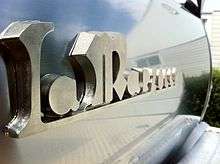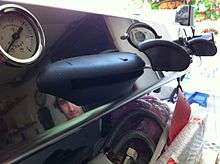La Marzocco
La Marzocco, founded in 1927, Florence, by Giuseppe and Bruno Bambi, has traditionally specialized in producing high end, hand-crafted professional espresso coffee machines geared towards excellence.[1][2][3][4] The Florentine town of Scarperia hosts the factory and company headquarters [5] and its branch offices are located in Barcelona, London, Melbourne, Milan, Seattle, Seoul and Sydney.[6] La Marzocco continues to maintain the tradition of an artisanal approach in its production process. The development of its knowhow is generational and the craftsmanship is accompanied by the pursuit of the most advanced technologies.[7] A historical Italian maker of espresso machines, its products are consistently considered in the top rank,[8] particularly since the introduction of the dual-boiler GS series in 1970. Today, La Marzocco equipment are widely used in specialty coffee shops.[9][10]


History
After the Bambi brothers manufactured their first coffee machine Fiorenza on commission, they established their own activity in 1927 specialized in hand-crafting espresso machines, and named it after the Marzocco – the city of Florence's symbol of victory and conquest and whose image and values were chosen to represent the company brand.
As coffee consumption increased in Italy throughout the 20th century, La Marzocco over the decades introduced technological innovations, improved ergonomics and barista tools, establishing industry standards.
In 1939, La Marzocco patented the first espresso machine with a horizontal boiler, which, in comparison to the previous vertical structure, organized the brew groups in a horizontal fashion, which provided efficiency for the barista and an opportunity to engage with customers.
Following the introduction of the lever machines in 1947, La Marzocco began to manufacture its own models, keeping in mind design that would refer to the context of the environment and time.
In the early 1950s, Piero Bambi, who is currently Honorary President, joined the business of his father Giuseppe and his uncle.
From 1964 to 1970 La Marzocco produces the Poker series.[11][12][13]
In 1964, the Poker series of hydro-compression machines was launched, by which the piston, unlike lever machines, was lifted and pressed during brewing by means of a diaphragm, that was inflated by steam pressure generated by the boiler.
In 1968, Giuseppe Bambi's "Vulcano" grinder was awarded the Decorative and Industrial Arts Prize at the 14th Triennale di Milano exhibition.
In 1970, La Marzocco patented its first series of professional semi-automatic, dual-boiler machines named "GS" (GS for Gruppo Saturo, or saturated group), winning the Qualità e Cortesia-Toscana prize in 1971. The two independent boilers separated coffee extraction from steam production thus, together with the saturated groups, ensured thermal stability and improved coffee quality in the cup since water now flowed through independent circuits.
From the seventies onward all machine boilers are manufactured in stainless steel. In 1982, the GS/2 - a redesigned GS model - won the Premio Andino de Fomento prize, and in 1988 the American firm ESF (future Espresso Specialists, Inc.) run by Kent Bakke became the exclusive supplier of La Marzocco machines for Starbucks until the latter, after 16 years, transitioned to super-automatic machines. Kent Bakke began importing La Marzocco machines to the United States in 1978.
In 1990, Piero Bambi designed his first machine in its entirety, the "Linea Classic", which proved to be very technician-friendly. In 1994, La Marzocco International, LLC., a formal partnership between the Bambi family and a team of American coffee enthusiasts and Italian partners, led by Kent Bakke, is established.
In 1997, the FB/70 coffee machine (FB for Fratelli Bambi) is launched to celebrate La Marzocco's 70th anniversary and in 2000 the "Swift" grinder is awarded Best New Product at the San Francisco SCAA conference, being the first patented model to combine dosing, grinding and automatic tamping technologies.
In 2001, La Marzocco began the first of 8 years as sponsor of the World Barista Championship in its endeavor to boost the barista profession and engage with end customers as specialty coffee communities developed worldwide.
In 2005, the GB/5 machine (named after Piero's wife, Giovanna Bambi) is introduced, equipped with a CPU board and improved thermo-stability in light of the introduction of "PID" technology.
The FB/80 was manufactured for the 2006 World Barista Championship in Bern to mark the company's 80th anniversary, whereas the GS/3 model is presented in 2007. That year, La Marzocco also launched the "Songwa Estate Project", a non-profit joint venture aiming to provide educational experiences for members of the specialty coffee industry and convey increased awareness of the bean-to-cup cycle through local, charitable support and commitment.
In April 2009, the company presented its pressure profile technology at SCAA on a prototype, which, for the first time, enabled the barista to have direct pressure control at any point during extraction. Soon after, its branch in the USA is established, the Italian factory is relocated to nearby Scarperia, with a showroom and training center, and La Marzocco's first "Out of The Box" event is inaugurated in Milan. The redesigned Vulcano grinder, with Mazzer grinder technology, is introduced on this occasion, and the pressure profile technology introduced earlier in the year is built into the newly designed Strada EP (electronical paddle). The Strada MP (mechanical paddle) is on display as well. The Strada EE (semi-automatic) is introduced in January 2014.
In 2013, the Linea PB, named after the machine's designer Piero Bambi model is introduced at the Boston SCAA conference. The Linea PB refashions the Linea Classic and is distinguished by a new proprietary software platform which controls brewing time and volume. The Vulcano Swift grinder is introduced as well and incorporates the Swift technology with the design of the Vulcano.
The Strada EE (semi-automatic) is introduced in January 2014. [14]
The Strada AV prototype is introduced in 2015 and launched in 2016,[15] featuring Italian design and user-friendly interface. The Strada AV is for customers who appreciate the familiarity of volumetric controls and who seek repeatability and consistency in high-volume settings, presenting the most stable brewing platform thanks to the thermal stability system and individual coffee boilers. The Strada machine, with the AV model, is equipped for the very first time with High Performance Steam Wands. [16]
In 2015, the company launches the Linea Mini for the home. Born from the commercial espresso machine, the Linea Classic, the Linea Mini is equipped with a dual boiler, a pre-programmed pre-infusion feature and is optimized for the home in light of a built-in water reservoir, standard appliance power needs and its countertop footprint. The Linea Mini was awarded Best New Product and the People's Choice awards at SCAA (Seattle) in April 2015.[17]
In September 2016, the Strada AV received the "Best Product" Cafe Life Awards, London [18]
Use
La Marzocco Linea machines were used at almost all Starbucks locations for many years.
From 2000 to 2008, La Marzocco was the official sponsor and supplier of espresso machines for the "World Barista Championship".
Products
Espresso machines
Commercial espresso machines
- Strada
- Linea Classic
- Linea PB
- FB80
- GB5
All commercial machines are available in 2, 3 except the Linea Classic (also 1 and 4); the Linea PB, the GB5 and FB80 (also 4); the Strada EP (also available in 1 group).[19][20][21]
Home espresso machines
- GS3
- Linea Mini
Coffee grinders
Historical models
- Fiorenza [30][31]
- Marus [32]
- Eureka
- National
- Mondial
- Rondine
- Aurum
- Alba
- Olimpia
- Crema-espress
- Etruria
- Comet
- Poker
- GS
- GS/2
- SMALL
- FB/70
- Mistral
References
- ↑ Book "Un caffè in Toscana" by Andrej Godina – Edizione Medicea 2016
- ↑ http://coffeegeek.com/resources/pressreleases/2009-01-26-lamarzzoccomilan
- ↑ http://mag.sky.it/tag/mag/la_marzocco_1.html
- ↑ http://www.storienogastronomiche.it/la-marzocco-leggenda-italiana-macchine-da-caffe-come-ferrari/
- ↑ Book "Corporate Art, L'azienda come oggetto d'arte", catalogue edited by pptArt and curated by Giovanna Coltelli, Luca Desiata
- ↑ http://www.repubblica.it/economia/affari-e-finanza/2014/10/20/news/la_marzocco_il_caff_del_bar_sale_a_casa-98539359/
- ↑ http://nuvomagazine.com/magazine/spring-2014/la-marzocco
- ↑ "ILBA Coffee School and Barista Training". Retrieved 11 February 2013.
- ↑ http://tmagazine.blogs.nytimes.com/2010/06/09/ristretto-strada/?_r=0
- ↑ "La Marzocco – Linea". Retrieved 11 February 2013.
- ↑ Book "COFFEE-MACHINES FOR USE IN BARS
- ↑ https://store.lamarzocco.com/store/art-collection/history-book/
- ↑ Page 35, photos: number 19,20,21,22
- ↑ http://baristamagazine.epubxp.com/i/316287-jun-jul-2014/56
- ↑ http://sprudge.com/la-curva-la-marzoccos-new-concept-lever-espresso-machine-88515.html
- ↑ http://global.lamarzocco.com/en/strada-av/
- ↑ http://www.scaa.org/chronicle/2015/04/12/scaa-2015-best-new-product-winners-announced/
- ↑ http://awards.thecafelife.co.uk/index.php/awards/2-about-the-awards
- ↑ http://www.cremagazin.de/
- ↑ Print copy of "Crema", Oktober/November 2016, pages 92-96
- ↑ http://global.lamarzocco.com/en/espresso-machines/
- ↑ http://www.1st-line.com/store/pc/La-Marzocco-Vulcano-Automatic-Espresso-Grinder-p7887.htm
- ↑ https://www.seattlecoffeegear.com/la-marzocco-swift-espresso-grinder
- ↑ http://dailycoffeenews.com/2015/01/12/la-marzocco-home-and-mazzer-introduce-upmarket-home-lux-d-grinder/
- ↑ Book "Coffee Makers" by Enrico Maltoni
- ↑ http://www.espressomadeinitaly.com/en/the-book-profile.php
- ↑ Book "Espresso Made In Italy 1901-1962 - Collezione Enrico Maltoni, pages 132-125
- ↑ Book "Coffee Makers, 300 years of art & design" by Edward & Joan Bramah
- ↑ http://global.lamarzocco.com/en/1927-1929-en/
- ↑ http://www.mudeto.it/giuseppe_bambi.htm
- ↑ http://www.andreaantonelli.it/content/la-marzocco-semifinale-cibc
- ↑ https://books.google.com/books?id=pLNcuq70KskC&pg=PA111
External links
| Wikimedia Commons has media related to La Marzocco. |
- La Marzocco Company Homepage, accessed 26 February 2013